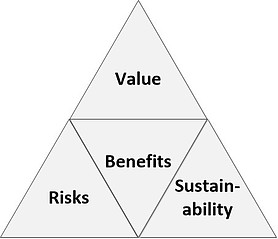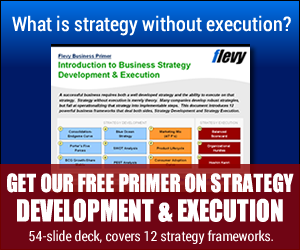Most project managers are familiar with the Triple Constraint, or Iron Triangle. It focuses inwardly on the project constraints of Scope, Time, and Cost. But what about an ‘outward’ focus – one focused more on strategic elements that also define whether the project is a success or not?
This post examines an outwardly focused set of constraints called the Benefits Triple Constraint.
What Is the Benefits Triple Constraint of a Project?

The Benefits Triple Constraint of a Project is an extension of the Project Triple Constraint, a powerful concept developed by the Project Management Institute (PMI). It was developed by Antonio Nieto-Rodriguez in “The Project Management Handbook: How to Launch, Lead, and sponsor Successful Projects” (paid link), published by Harvard Business Review.
The three constraining elements of the Benefits Triple Constraint are:
- Value – Tangible (i.e. financial return, regulatory compliance) or intangible (social benefits, added capabilities, improved employee morale) value to be provided by the project
- Sustainability – Measure along a continuum from immediate and one-time benefits to continuous long term benefits
- Risks – Level of unpredictability to be accepted, from lower but predictable benefits to potentially higher but less predictable benefits
The idea is that a change to any of these elements requires tradeoffs among the others in order to maintain a specific target level of Benefits.
Here is how tradeoffs are manifested between each of the elements:
- Value to Sustainability – There will need to be tradeoffs between short term/immediate Value and continuous long term Value, as well as between tangible and intangible Values.
- Value to Risks – As with investments, enduring greater Risk – higher potential volatility – usually leads to higher overall Value. There can be Risk tradeoffs involving choices between tangible vs intangible Values
- Sustainability to Risks – Sustainability means thinking longer term. Taking on greater Risks in select areas can lead to greater Sustainability.
Each of these elements also has a clear relationship with Benefits, at the center of the diagram:
- Value to Benefits – A higher level of tangible and/or intangible Value contributes to higher Benefits, whereas lower tangible/intangible Value brings lower Benefits. Note that the Value is not the only component of Benefits.
- Sustainability to Benefits – Sustainability leads to continuing Benefits for the long term.
- Risks to Benefits – Risks can add or subtract from Benefits. Higher Risks can lead to higher Benefits – but can also lead to no Benefits. There needs to be consideration for diversifying Risks sufficiently to make the combined effects positive.
Of course, as with the Project Triple Constraint, the magic of the Benefits Triple Constraint is in how all three of the elements interact in pursuit of a fixed target level of Benefits. There will always be a tradeoff among the three, such as the tradeoff between short term and long term Benefits (Value and Sustainability), and finding an optimal level of Risk.
The Benefits Triple Constraint in Practice
In the past, for project managers, the focus was more ‘inward’ – on the Triple Constraint, or Iron Triangle of Cost, Time, and Scope – to produce an output of specified Quality. This misses a great deal of the picture – such as, for example, the ‘why’ of the project! Cost, Time, and Scope do not cover the purpose of the project, so there is a need for an additional ‘outward’ focus toward external drivers.
One such an external driver is Benefits. Benefits are the reason why the project is being done in the first place. Naturally, the project manager – especially a Strategic Project Manager – needs to focus on the external driver such as Benefits.
In the ‘Project Management Handbook‘, Rodriguez offers the idea that not only is this outward focus needed, but it is actually constrained similar to the way Quality is constrained in the Project Triple Constraint. Let’s take yet another look at the three constraining factors for Benefits as discussed above:
- Value – A project manager needs to understand the target Value, both tangible and intangible, and define them with clear metrics. That’s usually easy for the tangible, but more challenging for intangible – but there is always at least one metric that you can identify for each of the near, medium, and long term for intangible Benefits.
- Sustainability – This is a clear case of tradeoffs – between short and long term Benefits. As a project manager, you will need to identify one or more target metrics for Sustainability.
- Risks – This is a bit of a different approach to risks than is normal practice in project management. These are tradeoff Risks, where there is a choice – a tradeoff – that stakeholders can make about taking on certain Risks in exchange for potentially greater Benefits.
Metrics are the common thread for clearly defining each of these three constraints. These metrics allow the Benefits Triple Constraint to be used in a similar way to the Project Triple Constraint.
With the Project Triple Constraint, a project manager can, in working with stakeholders, deal with tradeoffs. He/she can present stakeholders with possibilities for increased Scope in exchange for more Time and Cost, or deliver sooner (less Time) for a decrease in Scope and increase in Cost.
Similarly, the Benefits Triple Constraint gives project managers a tool to present outward tradeoffs to stakeholders. If stakeholders want more certainty – less Risk – they can have it if they are willing to trade off some Sustainability or Value. Or, they can have more Sustainability – if they are willing to adjust their short and long term Value targets.
Strategy and the Benefits Triple Constraint
Strategy is all about choice. As in tradeoffs of Scope, Cost, and Time in the Triple Constraint, strategists likewise need to consider the tradeoffs among Value, Sustainability, and Risks in setting target Benefits.
Strategists, in choosing target strategic Benefits, need to consider the three tradeoffs:
- Value – Identify the target tangible and intangible Value to be achieved with clear metrics. Analyze the necessary tradeoffs with Sustainability and Risks for vetting with decision makers.
- Sustainability – Identify the target Sustainability levels – goals not only for the results, but for the timing of the results. Short term results are needed to justify, and often validate, the strategic direction, but strategy by definition is a longer term endeavor. Attaching metrics to Sustainability becomes important. Information on tradeoffs are good preparation for vetting with decision makers.
- Risks – What are the big, or global, risks of various Courses of Action (COA’s)? Consider Risks with both tangible and intangible consequences. What effect will these have on Benefits?
Gathering all of this strategic information needs to consider tradeoffs among the constraints of Value, Sustainability, and Risks. Considering these three elements as constraints is good preparation for vetting with decision makers – and ultimately making good strategic choices.
The Benefits Triple Constraint and Project Management
Here is how using the Benefits Triple Constraint can be useful into the various project management roles.
- Portfolio Managers – In choosing among potential projects, use ‘sensitivity analysis’ to examine the range of outcomes that can result from projects in the potential portfolio. This requires a clear look at not only the Benefits for each project, but the range of Value, Sustainability, and Risks for each project.
- Program Managers – More focused on a particular strategic goal, the focus is more on a specific set of Benefits. Are those Benefits flexible or fixed? What tradeoffs can be made across Value, Sustainability, and Risks achieving the particular Benefits.
- Project Managers – Project managers are most focused on delivering, but they need to monitor progress toward the Benefits, and also maintain some flexibility. If there are potential Benefits adjustments to be made, what is the implication for Value, Sustainability, and Risks? Even with fixed Benefits, stakeholders may want to target a different level on any one of the three constraints, and PM’s need to be able to show them the tradeoffs.
Developing metrics for each of the constraints, and working through sensitivity analysis, is the key to leveraging the Benefits Triple Constraint.
Conclusion and Further Resources
Consider putting the Benefits Triple Constraint to work on your portfolio, program, or project. To think more strategically – and being a Strategic Project Manager – means developing an outward focused perspective in addition to an inward, project centric, focus.
You may find these resources helpful (paid links).

